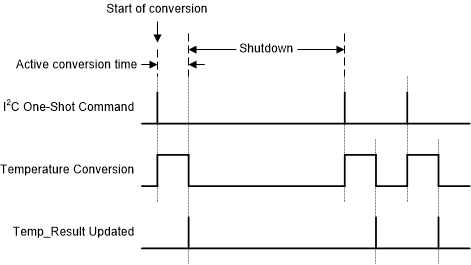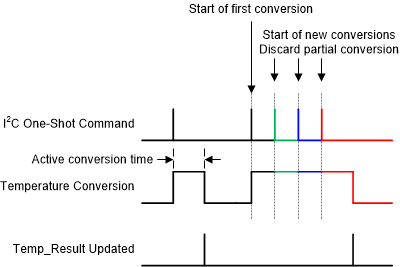SNIS214E june 2021 – july 2023 TMP114
PRODUCTION DATA
- 1
- 1 Features
- 2 Applications
- 3 Description
- 4 Revision History
- 5 Device Comparison
- 6 Pin Configuration and Functions
- 7 Specifications
- 8 Detailed Description
- 9 Application and Implementation
- 10Device and Documentation Support
- 11Mechanical, Packaging, and Orderable Information
Package Options
Refer to the PDF data sheet for device specific package drawings
Mechanical Data (Package|Pins)
- YMT|4
Thermal pad, mechanical data (Package|Pins)
Orderable Information
8.4.2.1 One-Shot Temperature Conversions
When the OS bit is set to 1b in the Configuration register, the TMP114 immediately start a one-shot temperature conversion. If the TMP114 is performing a temperature conversion, the device will stop the active conversion and discard the partial result, then start a new one-shot conversion. After completing the one-shot conversion the TMP114 will enter shutdown mode, the OS bit will be cleared, and the Mode bit will be set to 1b. If a one-shot conversion is triggered in continuous mode the device will enter shutdown mode after the one-shot conversion completes.
 Figure 8-5 One-Shot Timing Diagram
Figure 8-5 One-Shot Timing DiagramIf the One_Shot bit is continuously written as faster than the active conversion time of the TMP114, the device will continue to restart the temperature conversion with each new write to the One_Shot bit. TI recommends to avoid this behavior because the temperature result does not update until a conversion finishes. If the system triggers several continuous one-shot conversions, Figure 8-6 depicts how the device would continually partially finish new conversions and not update the Temp_Result register.
 Figure 8-6 One-Shot Continuous Trigger Timing Diagram
Figure 8-6 One-Shot Continuous Trigger Timing Diagram